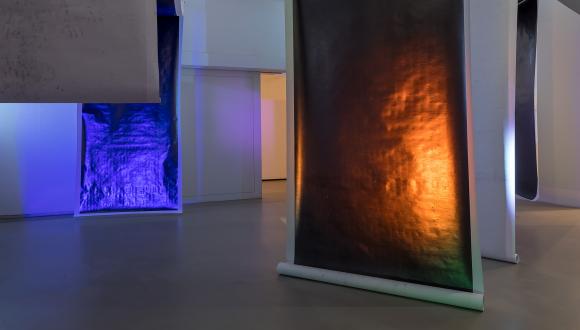Eshchar Hanoch Kliengbiel
Artist photo: Daniel Hanoch
Eshchar Hanoch Kliengbiel
Mes(ə)njer, 2023, pencil on paper, aluminum and projection
Eshchar Hanoch Kliengbiel has been exploring representations of outer space for years, using pencils to trace the terrain of reality by rubbing and embossing it on paper. He uses this technique, also known as frottage, to create images that are intensive and dense yet elusive, evading figurative representation. His work mes(ə)njer references an interstellar object that was first spotted in 2017. As it passed through our solar system at a great distance, too far to capture, there are no clear images of it. The object was dubbed Oumuamua, which is Hawaiian for a messenger from the distant past trying to reach us. And indeed, since it was discovered, many have been trying to imagine and speculate its properties. The space created by Kliengbiel summons a similar process of searching within the unknown. This is a deep, black world, with subtle nuances and varying textures that encourage lengthy observation. The physical experience of searching is amplified by the large sheets of paper, charged with the accumulative energy of the drawing hand. These blackened papers become a mass, an object imbued with days of labor-intensive work, marked and encoded in its scale: vertical, repetitive grooves that echo charting and probing procedures.
The traces of the drawing action create a world that emerges from a different time, one that can be grasped through the light reflected from it. In astronomy, the data collected from reflected light is the basis for assessing objects’ nature and properties. Similarly, in Kliengbiel site-specific installation, the light pushes the drawn field closer and farther from the viewers’ perception. Light, a wave that travels to us from the distant past, has been recorded via telescopes for many years, in an attempt to make sense of the universe. According to Dr. Iair Arcavi from the School of Physics and Astronomy, who accompanied the artists’ greenhouse, recently light has been joined by gravitational waves that revealed new information about the universe. With the shift from wall-mounted drawings to ones suspended and twisting mid-air, Kliengbiel has turned drawing into an object that has its own gravitational force. However, unlike the scientific, mechanical action, his free hand drawing focuses on the sensory experience of searching within the unknown.
Kliengbiel’s use of drawing to create an inscrutable visual reality brings to mind Derrida’s description of the link between drawing and blindness. In Memoirs of the Blind: The Self-portrait and Other Ruins Derrida characterized the practice of drawing as one that evades the scopic field, claiming that drawing holds the withdrawal and suspension of the visible, and even blinds those who look at it. In Kliengbiel’s parallel universe, observation requires constant movement, and so, even what has already come to light is doomed to slip away.


